ผลของนวัตกรรมการเรียนรู้ด้วยเกมกระดานในรายวิชาพลเมืองที่เข้มแข็งที่มีต่อผลสัมฤทธิ์ทางการเรียนและความพึงพอใจของนักศึกษาหลักสูตรครุศาสตรบัณฑิต มหาวิทยาลัยราชภัฏยะลา
Main Article Content
บทคัดย่อ
การวิจัยครั้งนี้เป็นการวิจัยและพัฒนา ตามรูปแบบของแอดดี 5 ขั้นตอน มีวัตถุประสงค์ 1) เพื่อพัฒนานวัตกรรมการเรียนรู้ด้วยเกมกระดานในรายวิชาพลเมืองที่เข้มแข็ง 2) เพื่อศึกษาผลสัมฤทธิ์ทางการเรียนของนักศึกษาที่เรียนรู้โดยใช้นวัตกรรมเกมกระดาน 3) เพื่อศึกษาความพึงพอใจของนักศึกษาที่เรียนรู้โดยใช้นวัตกรรมเกมกระดาน ประชากรคือนักศึกษาหลักสูตรครุศาสตรบัณฑิตชั้นปีที่ 1 จำนวน 448 คน เครื่องมือที่ใช้ในการวิจัย คือ 1) เกมกระดานดินแดนพลเมืองที่ผู้วิจัยพัฒนาขึ้น 2) แบบทดสอบวัดผลสัมฤทธิ์ทางการเรียน 3) แบบสอบถามความพึงพอใจ สถิติที่ใช้ในการวิเคราะห์ข้อมูล ได้แก่ ค่าเฉลี่ย และส่วนเบี่ยงเบนมาตรฐาน นำเสนอข้อมูลในรูปแบบตารางและการพรรณนาวิเคราะห์ ผลการวิจัยพบว่า 1) นวัตกรรมการเรียนรู้ที่ใช้คือ “เกมกระดานดินแดนพลเมือง” จำนวน 28 ชุด ประกอบด้วยเนื้อหาสำคัญ และกระดานการเล่นเกม ใช้เวลา 4 สัปดาห์ 2) นักศึกษามีผลสัมฤทธิ์ทางการเรียนหลังเรียนโดยใช้นวัตกรรมเกมกระดานสูงกว่าก่อนเรียน (=25.28, S.D.=2.37 /
=19.05, S.D.=3.15) และ 3) นักศึกษามีความพึงพอใจอยู่ในระดับมากที่สุด (
=4.60, S.D.=0.58)
Article Details

อนุญาตภายใต้เงื่อนไข Creative Commons Attribution-NonCommercial-NoDerivatives 4.0 International License.
เนื้อหาและข้อมูลในบทความที่ตีพิมพ์ในวารสารการศึกษาและนวัตกรรมการเรียนรู้ ถือเป็นข้อคิดเห็นและความรับผิดชอบของผู้เขียน ซึ่งกองบรรณาธิการวารสาร ไม่จำเป็นต้องเห็นด้วยหรือร่วมรับผิดชอบใด ๆ และไม่สงวนสิทธิ์การคัดลอกบทความเพื่อใช้ประโยชน์ทางวิชาการ แต่ให้อ้างอิงข้อมูลแสดงที่มาของบทความทุกครั้งที่นำไปใช้ประโยชน์
เอกสารอ้างอิง
Achawanantakul, S. (2016). Board game universe. Bangkok, Thailand: Salmon Publishing. [in Thai]
Areekul, C. (2020). The development of learning innovation as board game for enhancing the active citizen of the undergraduate students. Panna Panithan Journal, 5(2), 137-150. [in Thai]
Gardner, H. (1999). Intelligences reframed: Multiple intelligences for the 21st century. New York, NY: Basic Books.
Khammani, T. (2013). Science of Teaching: knowledge for effective learning process (17th ed.). Bangkok, Thailand: Chulalongkorn University Press. [in Thai]
Nachai, C., & Vongthatam, P. (2021). Designing and development of jump for baby frog board game to enhance problem solving thinking in step-by-step problem solving for late elementary school student. Journal of Education Khon Kaen University, 44(3), 1-19. [in Thai]
Panich, V. (2012). Learning methods for disciples in the 21st century. Bangkok, Thailand: Tathata Publication. [in Thai]
Preedakorn, A. (2014). Design a board game to study colourcircle for student in grade 6 (Master’s thesis). Srinakharinwirot University, Thailand. Retrieved from https://ir.swu.ac.th/jspui/bitstream/123456789/4450/2/Auttasead_P.pdf [in Thai]
Srisa-ard, B. (2011). Introduction of research (9th ed.). Bangkok, Thailand: Suweeriyasarn. [in Thai]
Thongpanit, P. (2017). Classroom design and learning management (3rd ed.). Nakhon Pathom, Thailand: Silpakorn University. [in Thai]
Tinsman, B. (2008). The Game Inventer’s Guidebook. Garden City, NY: Morgan James Publishing.
Wilairat, W. (2022). Results of learning management by using seterra geography online games in conjunction with the e-learning that affects academic achievement and attitudes of students world regional geography subject. Journal of Yala Rajabhat University, 17(3), 109-117. [in Thai]
Yodyingyong, K. (2009). Innovative Organization: Concept & Process. Bangkok, Thailand: Chulalongkorn University Press. [in Thai]
Yusof, S. A. M., Adzi, S. H. M., Din, S. N. S., & Khalid, N. (2016). A study on the effectiveness of a board game as a training tool for project management. Journal of Telecommunication, Electronic and Computer Engineering, 8(8), 171-176.


